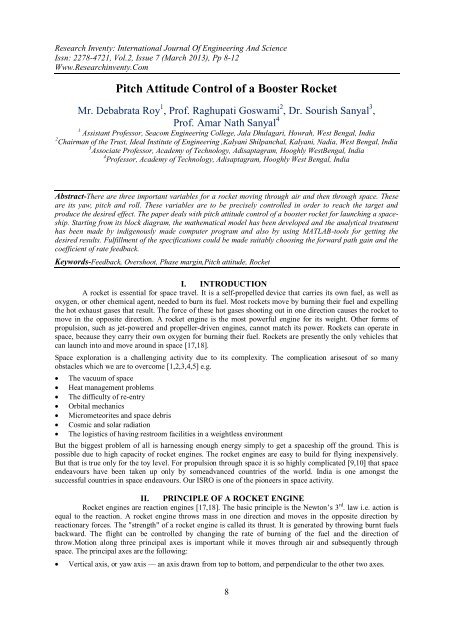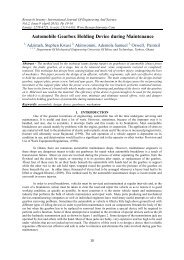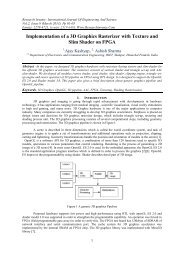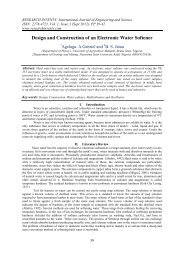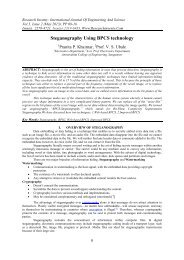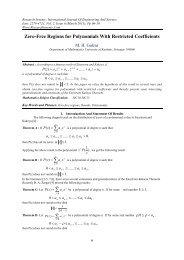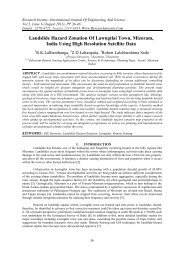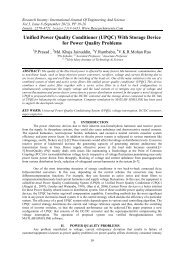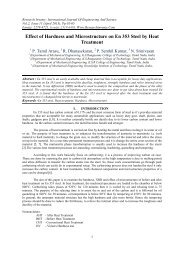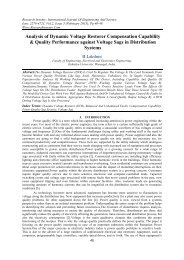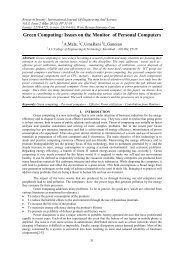Pitch Attitude Control of a Booster Rocket - Research Inventy
Pitch Attitude Control of a Booster Rocket - Research Inventy
Pitch Attitude Control of a Booster Rocket - Research Inventy
You also want an ePaper? Increase the reach of your titles
YUMPU automatically turns print PDFs into web optimized ePapers that Google loves.
<strong>Pitch</strong> <strong>Attitude</strong> <strong>Control</strong> Of A <strong>Booster</strong> <strong>Rocket</strong>The Nyquist plot does not intersect the real axis. So the gain margin is infinity. The phase margin is adequate.But the time-domain performance is not acceptable. The percentage overshoot is very high, much above thespecified value. Therefore, we make recourse to MATLAB-tools to get an acceptably good design.V. MATLAB-BASED ANALYSISNow we make recourse to MATLAB-tools for refinement <strong>of</strong> the design [11,12,13]. We set the dampingcoefficient arbitrarily at K = 0.1 and check the t-domain and f-domain performance. We find that thedovershoot is as high as 10.3%. Then we gradually increase the value <strong>of</strong> Kdto 0.14 in steps <strong>of</strong> 0.02 and checkthe same. The t-domain and f-domain (Bode plot) responses are given in fig. 2 to fig. 7. It is observed that thebest results are obtained for a damping coefficient <strong>of</strong> K = 0.14.dFig 2 Step response withKd= 0.1Fig. 3 Bode plot for Kd= 0.1For Kd= 0.1, we get a rather high overshoot <strong>of</strong> 10.3% at a peak time <strong>of</strong> 0.307 s. The rise time is 0.148 s and thesettling time is 0.785 s. The phase margin is 31.1 o at 14.1 r/s. This design is not acceptable as the overshoot ishigh. We want almost critical damping.Fig 4 Step response with K d = 0.1210
Phase (deg)Magnitude (dB)<strong>Pitch</strong> <strong>Attitude</strong> <strong>Control</strong> Of A <strong>Booster</strong> <strong>Rocket</strong>Fig 5 Bode plot with K d = 0.12For Kd= 0.12, we get a much reduced overshoot <strong>of</strong> 1.53% at a peak time <strong>of</strong> 0.68 s. The rise time is 0.162 sand the settling time is 0.585 s. The phase margin is 33.2 o at 15.1 r/s. This design is much better. But we shall tryto further reduce the overshoot and achieve critical damping.Fig 6 Time domain response for K d = 0.1440Bode DiagramGm = Inf dB (at Inf rad/sec) , Pm = 34.1 deg (at 16.2 rad/sec)200-20-40-60-80-90-135-18010 0 10 1 10 2 10 3Frequency (rad/sec)Fig. 7 Bode plot forKd= 0.1411
<strong>Pitch</strong> <strong>Attitude</strong> <strong>Control</strong> Of A <strong>Booster</strong> <strong>Rocket</strong>For Kd= 0.14, we get an overshoot <strong>of</strong> 0.0845% at a peak time <strong>of</strong> 1.02 s. The rise time is 0.195 s and the settlingtime is 0.582 s. The phase margin is 34.1 o at 16.2 r/s. The overshoot is now extremely small. We have almostreached critical damping. We accept the third design as final.The experimental results for different values <strong>of</strong> Kdare given in table 1TABLE 1 COMPARISON OF RESULTS (PA CONTROL)Damping coeff. Rise time Peak time Peak overshoot Settling time Phase marginK = 0.10 0.146 s 0.307 s 10.3% 0.785 s 31.1 odKd= 0.12 0.162 s 0.68 s 1.53% 0.585 s 33.2 oKd= 0.14 0.195 1.02 s 0.0845 0.582 34.1 oThe gain margin is infinity for all the cases.VI. CONCLUSIONA booster rocket is used to launch a space-ship from launch-pad to its spatial flight orasatellite to itsdesired orbit. The rocket has a powerful engine which operates on the principle Newton’s 3 rd . law. It is propelledcontrolled combustion <strong>of</strong> fuel as well as the burning material within the rocket. At first, it moves through air andthen through space. The speed has to be continuously controlled as the rocket leaves the launch-pad moves tohigher and higher altitude[17,18]. The motion control has to be exercised along three principle axes viz. yaw,pitch and roll. The paper deals with the design and performance evaluation <strong>of</strong> automatic control system intendedforpitch attitude control <strong>of</strong> the rocket[1]. The control is <strong>of</strong> proportional-derivative (PD) type, with controllablerate feedback so as to keep the system only very slightly under damped retaining the phase margin above aspecified value. It was tried at first to reach the target by analytical treatment and self-made program. But theattempt failed. Then recourse was made to MATLAB-tools [11,12,13]. The specifications could be reached bysimultaneous change <strong>of</strong> the forward path gain and the coefficient <strong>of</strong> rate feedback.REFERENCESJournal Papers:[1] M.D. Shuster, ―A survey <strong>of</strong> attitude representations‖, J. Astronautical Science., 41,pp. 439–517, 1993.[2] Y. Umetani and K. Yoshida. ―Resolved motion rate control <strong>of</strong> space manipulators with generalized jacobian matrix‖, in IEEETransactions on Robotics and Automation,5(3): pp. 303-314, 1989.[3] E. Papadopoulos and S. Dubowsky, ―On the nature <strong>of</strong> control algorithms for free-floating space manipulators‖, in IEEE Trans. onRobotics and Automation,7(6): pp. 750-758, December, 1991.[4] D. Nenchev, Y. Umetani and K. Yoshida, ―Analysis <strong>of</strong> a redundant free-flying spacecraft/ manipulator system‖, in IEEE Trans. onRobotics and Automation, 8(1):1-6, 1992.[5] O. Egeland and J.R. Sagli, ―Coordination <strong>of</strong> motion in a spacecraft/manipulator system‖, in Int. Journal <strong>of</strong> Robotics <strong>Research</strong>,12(4): pp. 366{379, August, 1993.Books:[6] K. Ogata, ―Modern control engineering‖, Pearson Education[7] S.M. Shinners, ―Modern control system theory and design‖, John Wiley and Sons.[8] A.M. Law and W.D. Kelton, ―Simulation, modeling and analysis‖, Mcgraw-Hill, New York, 2 nd . Edition, 1991.[9] J.R. Wertz (Ed.): ―Spacecraft attitude determination and control‖, .Kluwer Academic Publishers, Dordrecht, 1978.[10] R.H. Battin,―An introduction to the mathematics and methods <strong>of</strong> astrodynamics‖, AIAA Education Series, Reston, VA (1999).[11] R. Pratap, ―Getting strated with MATLAB7‖,Oxford, Indian Ed,[12] J.J. D’Azzo , C.H. Houpis and S.N. Sheldon, ―Linear control system analysis and design with MATLAB‖, 5e, Marcel DekkerInc. New York, BASEL[13] A.J. Grace, N. Laub, J.N. Little and C. Thomson, ―<strong>Control</strong> system tool box for use with MATLAB‖, User Guide, Mathworks,1990.[14] E.Kreyszig, ―Advanced engineering mathematics‖, Wiley, New York, 2001.[15] V. Rajaraman, ―Computer-oriented numerical methods‖, PHI, 1995[16] K. Deb,‖Optimization for engineering design‖, PHI, 2010E- References:[17] ―Free Encyclopedia <strong>of</strong> Wikipedia‖, www.wikipedia.com12


